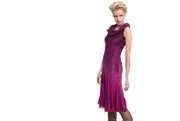The New Selling Point: Made in the USA
About 95 percent of the clothes sold in the United States are sewn in far-flung overseas factories in places such as China, Vietnam and Bangladesh, according to International Development Systems, a Washington, D.C., company that provides data and analysis regarding trade policies. But retailers and showroom representatives have noticed a burgeoning trend: More customers are searching for “Made in USA” products because they want to bolster the economy and create more domestic jobs.
This was quite evident to Shelley Komarov, who was way ahead of the trend. The Los Angeles designer and former costume designer who started her Komarov label of dresses and sportswear 15 years ago. Komarov’s biggest U.S. customer is the Nordstrom chain of stores, where she makes periodic personal appearances around the country to tout her line.
At a recent appearance at the Nordstrom store in Riverside, Calif., the designer stood before an audience of 200 women, who had just watched a Komarov fashion show, and told the group that her high-end clothing line was not only made in the United States but in Los Angeles.
“They all started applauding,” said the Russian-born designer in her accented English, noting this wouldn’t have happened a few years ago. “People feel it is time for the economy and for some businesses to come back to the United States.”
Barbara Lesser, another Los Angeles designer who produces 100 percent of her line of updated womenswear in the United States, is seeing a pay-off.
“We promote that we are made in America on all our hangtags,” said Mark Lesser, Barbara’s husband and president of Barbara Lesser Fibers. “And we get calls from stores and consumers who say, ’Wow, it is nice to finally find something made here.”
No one is quite sure when this quiet groundswell of domestic loyalty took hold. Some say it lifted off last year as the unemployment rate rocketed toward recent record highs. Last year, California had one of the highest unemployment rates in the country, hitting 12.5 percent in early 2010 before inching down t o 12 percent in March. Others believe it gained force in the last few months as more articles and television shows talk about the flight of manufacturing jobs to foreign locations. A recent Moody’s analytics report noted that if consumers spent an extra 1 percent on U.S. goods, it would create 200,000 extra jobs.
Julie Marcher, who runs the Julie & Stuart Marcher Showroom with her husband at the Gerry Building in downtown Los Angeles, believes more people have been thinking about domestically made apparel ever since Los Angeles ABC affiliate KABC Channel 7 did a series of stories earlier this year about buying domestically. An ABC7/Survey USA poll revealed that 66 percent of Los Angeles and Southern California residents said they checked labels to see if goods were made in America.
But one program in the TV series showed news reporters entering people’s homes and combing the contents for American-made goods, which were practically nonexistent.
“The ’Made in USA’ movement has been going on, but it culminated in the last four or five weeks,” said Marcher, who has noticed more retailers walking into her showroom recently with “Made in USA” on their minds.
Neetu Malik, who carries a number of U.S.-made lines in her eponymous Gerry Building showroom, has also detected a rising swell of interest in locally made garments. But it is particularly strong in regions of the country where residents are at the forefront of other trends such as the green revolution, organic food and fabric, and alternative energy.
“It is mostly in northern California; the Northwest, like Oregon; and the Northeast, such as Connecticut, New Hampshire and upper-state New York,” she observed.
Fog City, U.S.A.
The loyalty to Made in America products is most evident in San Francisco, which has always been a progressive metropolis. In 2000, San Francisco signed a wide-ranging livingwage law that raised hourly salaries to $9.92 an hour, well above California’s minimum wage of $8 an hour (which is higher than the federal minimum wage of $7.25). In 2006, San Francisco made it mandatory that everyone who lives and works in the city be given access to affordable healthcare. And in 2007, San Francisco was the first U.S. urban hub to ban plastic shopping bags from large supermarkets and pharmaceutical chains.
So it would only seem natural that the city’s web of specialty boutiques would be proponents of the Made in America trend.
Kati Koos, whose self-named clothing store and gift gallery on Sutter Street sits one block away from Union Square, has been in business for 18 years. She has gradually gravitated to domestically made goods, which now make up 85 percent of her merchandise. “People who come to San Francisco want to buy things from here,” she noted. “The first thing I ask at market is, ’Where is this made?’”
She even noticed at the San Francisco International Gift Fair that more people were putting out signs showing their lines are made in the United States. “You didn’t see that two or three years ago,” she said.
Michael Barber, co-owner of the Paparazzi boutiques in the San Francisco area, said about 40 percent of his merchandise comes from the United States. But in this day and age, it is tough to do 100 percent American-made. “That doesn’t work in the fashion industry—or any industry,” he said.
Price conscious
For many retailers, carrying domestically made goods sounds like a brilliant idea until they consider how much it costs.
Many consumers would like to be loyal to domestic manufacturing, but they also have to be loyal to their pocketbooks.
“Retailers do ask for Made in America goods, but then they like the Chinese prices,” said Sarah Kirakossian, who works at the Arlene Henry Sales showroom, which carries several U.S.-made lines.
With that in mind, it tends to be the tonier specialty stores and department stores that are able to stock a significant portion of their merchandise with domestic products. “You can’t produce in America unless you are in the higher end of the moderate market,” admitted Barbara Lesser Fibers’ Mark Lesser.
He noted that his company’s made–in– Los Angeles sweaters carry an $80 wholesale price point, which is too expensive for major mid-tier department stores.
And Shelley Komarov’s dresses, which are known for their labor-intensive pleating, retail for around $200 to $300. “They are pricy items,” Komarov said. “But the minute the customer hears it is made in the United States, they like it.”
























